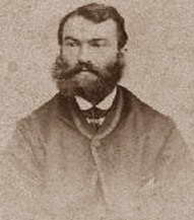<Back to Index>
- Surgeon James Parkinson, 1755
- Painter Antoine Coypel, 1661
- Founder of the General German Workers' Association (ADAV) Ferdinand Lassalle, 1825
PAGE SPONSOR

James Parkinson (11 April 1755 – 21 December 1824) was an English apothecary surgeon, geologist, paleontologist, and political activist. He is most famous for his 1817 work, An Essay on the Shaking Palsy, in which he was the first to describe "paralysis agitans", a condition that would later be named Parkinson's disease after him.
James Parkinson was born in Shoreditch, London, England. He was the son of John Parkinson, an apothecary and surgeon practising in Hoxton Square in London. In 1784 Parkinson was approved by the City of London Corporation as a surgeon. He never became a physician as many mistakenly call him.
On May
21, 1783, he married Mary Dale, with whom he subsequently had six
children. Soon after he was married, Parkinson succeeded his father in
his practice in 1, Hoxton
Square. He believed that any worthwhile physician should know shorthand,
at
which he was adept. In
addition to his flourishing medical practice, Parkinson had an avid
interest in geology and paleontology, as well as the politics of the day. Parkinson
was a strong advocate for the under-privileged, and an outspoken critic
of the Pitt government.
His
early career was marred by his being involved in a variety of
social and revolutionary causes, and some historians think it most
likely that he was a strong proponent for the French
Revolution. He published nearly twenty political pamphlets in the
post-French Revolution period, while Britain was in political chaos.
Writing under his own name and his pseudonym "Old Hubert", he called
for radical social reforms. Parkinson
called for representation of the people in the House
of
Commons, the institution of annual parliaments, and universal suffrage. He was a member of several secret political societies,
including the London
Corresponding
Society. In 1794 his membership in the organization
led to his being examined under oath before William Pitt and the Privy
Council to give
evidence about a trumped-up plot to assassinate King
George
III. He refused to testify regarding his part in "The
Pop-Gun Plot", until he was certain he would not be forced to
incriminate himself. The plan was to use a poisoned dart fired from a
"pop gun" to bring the king's reign to a premature conclusion.
Fortunately for Parkinson, no charges were ever brought against him but
several of his friends languished in prison for many months before
being acquitted. Parkinson
turned away from his tumultuous political career, and between 1799 and
1807 published a number of medical works, including a work on gout in 1805. He was also
responsible for the earliest writings on the subject of peritonitis in English medical
literature. Parkinson
was the first person to systematically describe 6 individuals with
symptoms of the disease that bears his name. He did not actually
examine these patients himself but observed them on daily walks. It was Jean
Martin
Charcot who
coined the term "Parkinson's
disease" over 60 years later. Parkinson
was also interested in improving the general health and well-being of
the population. He wrote several medical doctrines that exposed a
similar zeal for the health and welfare of the people that was
expressed by his political activism. He was a crusader for legal
protection for the mentally ill, as well as their doctors and families. In 1812
Parkinson assisted his son with the first described case of appendicitis in English, and the first
instance in which perforation was shown to be the cause of death. Parkinson's
interest
gradually turned from medicine to nature, specifically the
relatively new field of geology,
and paleontology.
He
began collecting specimens and drawings of fossils in the latter part of the
eighteenth century. He took his children and friends on excursions to
collect and observe fossil plants and animals. His attempts to learn
more about fossil identification and interpretation were frustrated by
a lack of available literature in English, and so he took the decision
to improve matters by writing his own introduction to the study of
fossils. In 1804
the first volume of his Organic
Remains
of a Former World was
published. Gideon
Mantell praised it
as "the first attempt to give a familiar and scientific account of
fossils". A second volume was published in 1808, and a third in 1811.
Parkinson illustrated each volume and his daughter Emma coloured some
of the plates. The plates were later re-used by Gideon Mantell. In 1822
Parkinson published the shorter "Elements of Oryctology: an
Introduction to the Study of Fossil Organic Remains, especially of
those found in British Strata". Parkinson
also contributed several papers to William
Nicholson’s "A Journal of Natural Philosophy, Chemistry and the
Arts", and in the first, second, and fifth volumes of the "Geological
Society’s Transactions". On
November 13, 1807, Parkinson and a number of other distinguished
gentlemen met at the Freemasons'
Tavern
in London. The gathering included such great names as Sir Humphry
Davy, Arthur
Aikin and George
Bellas
Greenough. This was to be the first meeting of the Geological
Society
of London. Parkinson
belonged to a school of thought, Catastrophism,
that
concerned itself with the belief that the Earth's
geology
and biosphere were shaped by recent large-scale cataclysms. He
cited the Noachian
deluge of Genesis as an example, and he
firmly believed that creation and extinction were processes guided by
the hand of God.
His
view on Creation was that each 'day' was
actually a much longer period, that lasted perhaps tens of thousands of
years in length.
Parkinson's
life
is commemorated with a stone tablet inside the church of St
Leonard's,
Shoreditch, where he was a member of the congregation; his grave is in the churchyard of St Leonard's. In addition, there is a
blue plaque at 1 Hoxton
Square, marking the site of his home. Several fossils were also
named after him.